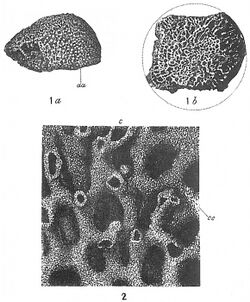Biology:Syringammina
| Syringammina | |
|---|---|

| |
| Scientific classification | |
| Domain: | Eukaryota |
| Clade: | Diaphoretickes |
| Clade: | SAR |
| Phylum: | Retaria |
| Subphylum: | Foraminifera |
| Class: | Monothalamea |
| Clade: | Xenophyophorea |
| Order: | Psamminida |
| Family: | Syringamminidae |
| Genus: | Syringammina Brady, 1883[1] |
| Type species | |
| Syringammina fragilissima | |
| Species | |
| |

Syringammina is a xenophyophore found off the coast of Scotland, near Rockall.[4] It is one of the largest single-celled organisms known, at up to 20 centimetres (8 in) across.[5] It was first described in 1882 by the oceanographer John Murray, after being discovered on an expedition in the ship Triton which dredged the deep ocean bed off the west coast of Scotland in an effort to find organisms new to science. It was the first xenophyophore to be described and at first its relationship with other organisms was a mystery, but it is now considered to be a member of the Foraminifera.[6][7]
The organism appears as an agglomeration of sediment a few centimetres across, a sandy ball that easily crumbles when removed from the seabed. It consists of a single cell which expands to form hundreds of hollow branched and interconnecting tubes; these secrete an organic cement to which particles of sediment and sand adhere, forming a crusty structure called the test. As the test grows, the cell withdraws from parts of it, which are then colonised by other organisms, such as nematodes. The single cell has no cell divisions but is multinucleate, having multiple nuclei.[5]
It is not known how the organism feeds or reproduces. It may be a filter feeder, drawing water through the tubes and sifting out the nutritious particles. Alternatively, much faecal matter accumulates in the tubes, and it has been suggested that it feeds on the bacteria that colonise the waste. This theory is supported by the fact that it has high concentrations of lipids within its cytosol, which suggests that it may feed on bacteria from the sediment that makes up the tubes.[8] In common with other xenophyophores, the organism has tiny crystals of barium sulphate, known as granellae, scattered throughout the cytosol.[5]
Syringammina fragilissima, the first xenophyophore known to science, was described by Henry Bowman Brady in 1883, from specimens dredged from the Faroe Channel.[9]
S. minuta, described by Pearcey in 1914, was not properly figured and the original specimen is unaccounted for.[10]
The species Syringammina limosa was described in 2018 from the Sea of Okhotsk at a depth of 3300 metres.[11]
See also
- Largest organisms
References
- ↑ Brady, H. B. (1883). Note on Syringammina, a New Type of Arenaceous Rhizopoda. Proceedings of the Royal Society of London. 35(224-226): 155-161., available online at https://doi.org/10.1098/rspl.1883.0031
- ↑ Brady, H. B. (1883). Note on Syringammina, a New Type of Arenaceous Rhizopoda. Proceedings of the Royal Society of London. 35(224-226): 155-161., available online at https://doi.org/10.1098/rspl.1883.0031
- ↑ The Lost City 2005 Ocean Explorer, NOAA.
- ↑ "As large as life". New Scientist 2157. October 24, 1998. https://www.newscientist.com/article/mg16021573.700-as-large-as-life.html.
- ↑ 5.0 5.1 5.2 Michael Marshall (February 3, 2010). "Zoologger: 'Living beach ball' is giant single cell". New Scientist. https://www.newscientist.com/article/dn18468.
- ↑ J. Alan Hughes & Andrew J. Gooday (2004). "Associations between living benthic foraminifera and dead tests of Syringammina fragilissima (Xenophyophorea) in the Darwin Mounds region (NE Atlantic)". Deep-Sea Research Part I: Oceanographic Research Papers 51 (11): 1741–1758. doi:10.1016/j.dsr.2004.06.004. Bibcode: 2004DSRI...51.1741H.
- ↑ Gooday, A.J; Aranda da Silva, A.; Pawlowski, J. (2011). "Xenophyophores (Rhizaria, Foraminifera) from the Nazare Canyon (Portuguese margin, NE Atlantic)". Deep-Sea Research Part II 58 (23–24): 2401–2419. doi:10.1016/j.dsr2.2011.04.005. Bibcode: 2011DSRII..58.2401G.
- ↑ Laureillard, J., L. Méjanelle, and M. Sibuet. "Use of Lipids to Study the Trophic Ecology of Deep-sea Xenophyophores." Marine Ecology Progress Series 270 (2004): 129-40. Print.
- ↑ Brady, Henry Bowman (1883-01-01). "IV. Note on syringammina, a new type of arenaceous rhizopoda". Proceedings of the Royal Society of London 35 (224–226): 155–161. doi:10.1098/rspl.1883.0031. https://royalsocietypublishing.org/doi/10.1098/rspl.1883.0031.
- ↑ "Synoptic checklist and bibliography of the Xenophyophorea (Protista), with a zoogeographical survey of the group" (in en). https://www.researchgate.net/publication/242173224.
- ↑ Voltski, Ivan; Weiner, Agnes K. M.; Tsuchiya, Masashi; Kitazato, Hiroshi (2018-08-01). "Morphological and genetic description of Syringammina limosa sp. nov., the first xenophyophore (Foraminifera) from the deep Sea of Okhotsk" (in en). Deep Sea Research Part II: Topical Studies in Oceanography. The Russian-German deep-sea expedition SokhoBio (Sea of Okhotsk Biodiversity Studies) 154: 32–46. doi:10.1016/j.dsr2.2017.12.001. ISSN 0967-0645. Bibcode: 2018DSRII.154...32V. http://www.sciencedirect.com/science/article/pii/S0967064517303193.
External links
- Article containing a photograph of a specimen from New Scientist
Wikidata ☰ {{{from}}} entry
 |

